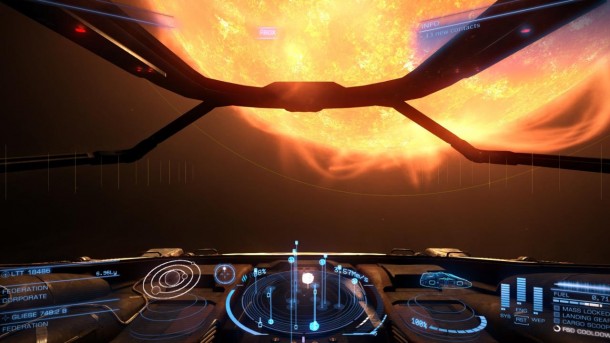Elite: Dangerous Review
I am skillfully piloting my Zorgon Peterson brand Hauler through the rotating port of one of the eighty bazillion space stations in Elite: Dangerous. I fiddle with system checks on the holographic dashboard, wearing an expression of self-satisfied disinterest. Almost casually, I flip on the landing gear, invert my ship, and reverse thrusters, deftly drifting into landing pad number 44. I'm master and commander at the far side of the galaxy. I'm an ace. I'm the Star Lord. I'm...not docking?
Well. In a Whedonesque bit of bathos, Elite: Dangerous has glitched, and instead of the chirps of the landing guidance system, I'm being rewarded with the angry, electric snapping sound of my shields grinding on raw space station. No problem--I'll just cancel my docking request and resend it. I make the requisite clicks. And that's when things go very, very bad. "TRESPASS WARNING" flashes in deadly red text, and a timer begins counting down from thirty. "Loitering is a crime punishable by death," a female voice helpfully intones over a loudspeaker, as I'm perforated by what is, frankly, an irresponsible amount of laser fire from station security. End scene.
Lasers, explosions, dystopian public service announcements...that was one of my more dramatic deaths in Elite: Dangerous, but it's actually in the routine of the parts preceding my demise that I experienced the quintessential sci-fi experience. It's the genre's unique thrill: seeing the incredible trappings of futuristic life fade into the background, turn second nature, become mundane. It's Chris Pratt punting alien lizards while dancing along to a cassette, or the way Cowboy Bebop segues from interstellar gateways to bell peppers and beef. The science is still there, of course, doing all the work to keep the cold void of space safely on the other side of the glass. But all the fussy details have been neatly elided, the edges gently worn and rounded from use. That's my kind of sci-fi, and Elite: Dangerous often delivers it, like a spacefaring Euro Truck Simulator.
But in Elite, that sort of familiarity is hard-won. Even if you do your due diligence in the game's tutorial--tampering with the controls, pitching and rolling until you can parallel park at half the speed of light--the game's vision of spaceflight simulation still proves aloof. It's quite a thing, to dump a player into a scale representation of the entire Milky Way galaxy with only the vaguest hint of direction. There's no expressed goal in Elite: Dangerous; if you're looking for signs of progress they might be found in your reputation, a one-word descriptor ranging from "Harmless" to "Elite." But you could just as easily mark your improvement by the accrual of bigger and better ships, or in cold hard credits. A few intersecting occupations are accounted for: trader or smuggler, pirate or bounty hunter… and miner for those who prefer the company of floating bits of rock.
You have the freedom to go where you will and do what you want, but friction and false starts ensure that you won't be going there very fast or doing it very efficiently for some time. There's the inscrutability of your cockpit dashboard to contend with, loaded for bear with functionality that never gets articulated. That, and the imposing galaxy map, with its disorienting scale and legion of similar-sounding star systems. There are the glitches, like the time I spawned into the game to find a shiny new "Wanted" label I'd earned for no reason, or the aforementioned docking snafu. And there's all the missing data that can only be found outside of the game, from critical trade information to a plain-words explanation of how your ship's fuel tank actually works.


It wasn't until I totalled the shiny new spacecraft I'd been loaned and tried to make a go of it with the chintzy, standard-issue Sidewinder that I came to better grasp Elite's systems. The Sidewinder's rinky-dink frame shift drive forced me to take a more considered look at the galaxy map or risk leaving myself stranded between long system jumps. The absence of a docking computer meant that I'd be guiding the little craft into station on manual instead having the autopilot unceremoniously dump me onto landing pads. Elite is at its best when it’s forcing this more deliberate level of engagement, and I wish it happened more often. Tellingly, there's a pre-flight systems checklist that you can run through every time you take off, but Elite pulls its punch and lets you opt out. Even as I write this, I'm hurtling through space on a trade run at 16.64c, window minimized. It's perfectly possible, as it turns out, to conduct an intragalactic smuggling operation en passant. All that's necessary is the occasional alt + tab to make sure I'm not about to plow headlong into a star.
Once you've gotten your space legs under you and upgraded to something resembling a viable ship, it's easy to settle into semi-comfortable routine. Check the station bulletin board for courier missions or a tantalizing bounty payout, or the commodities market for a decent-looking buy-low option. Set a course, leapfrogging from star to nearby star. Arrive at your destination system, drop out of hyperspace and into a slightly slower supercruise, and throttle down so that you don't overshoot the beacon for your target station or combat zone. Deliver your supplies, ply your wares, blow up your mark, and repeat. Profits can be reinvested in your ship once you're safely docked, towards upgraded cargo holds or, say, advanced lasers. The nuances of kitting out a good ship are as obscure as any of the rest of Elite's systems, but generously, anything bought can be sold back for the same price if it turns out you've made a colossal error. Elite is less charitable when it comes to trading outside the garage. The game plays it coy when you look for trade data in other star systems--the best you can hope for is a suggestion that "maybe" a given product is "sometimes" exported from some station therein. Often times it isn't there, however, and let me tell you: there's a real novel frustration in traveling eighty light years away to find out they're all out of tea this week.

You have the freedom to go where you will and do what you want, but friction and false starts ensure that you won't be going there very fast or doing it very efficiently for some time.
It’s enough to drive a fellow to tea piracy, which happens to be well accommodated for in Elite's laissez-faire frontier. One can buy interdiction systems that forcibly drag an NPC or a player character's ship out of supercruise, opening them up to predation should they fail a minigame of “keep the crosshairs aligned.” Thus engaged, combat unfolds with straightforward but precise dogfights, where momentum and trajectory are the secret killers, not the missiles or lasers. I confess that I’m not particularly good at this sector of Elite, whether it comes to gauging an enemy’s skill from afar, or sticking to his six in the heat of battle. I even have trouble remembering to keep my speed at the sweet spot that lets you turn quickest. But a more practiced hand can make use of the more advanced tactical offerings, redistributing power to the parts of one's ship in the most need, or pulling the slick-looking maneuvers conferred by a stick and throttle system or Oculus VR headset (the peripherals pair so naturally with Elite that the game almost seems built just to leverage them). That's a wrinkle I've yet to master, but the promise of dramatic, large-scale battles between federal armadas tucked away in distant systems is more than enough incentive to learn the ropes. Would that you could effectively team up with other players to run them--Elite’s tools for inter-player cooperation are almost nonexistent.
The little joys of Elite: Dangerous' solo play suffice, though. Peals of thunder rumble past your ship in supercruise, and I don’t care if they're as fake as the pumped-in crowd noise at the Georgia Dome, because they sound great. Ditto for the sudden, 18-wheeler horn that accompanies a drop out of hyperspace into close proximity with a giant, iridescent star. The hottest of these visibly cook your ship if you get too close, which happens to be a requirement if you want to use a fuel scoop to replenish your stores on the fly. They're also functional light emitters in the game's engine, and you can see the shadow of your craft ripple down the side of a station if you get between the two bodies. There are a few curiosities out in the ether, too, though they’re harder to appreciate if you’re not an astrophysics hobbyist. For example, the chance discovery of a station orbiting, well, nothing, struck me as odd. There’s a term for this, apparently: a “LaGrange Point,” but instead of making me contemplate the wonder of the universe, it mostly brought ZZ Top to mind. Still, this a game where light years can be hopped in a moment, and yet the prospect of traveling from one end of Elite's map to the other remains inconceivable. It's hard to overstate how remarkable that is, how the simple act of playing a game can engender such an acute awareness of size and scale.
It's an accomplishment in its own right, but that breadth doesn't come into play elsewhere in the experience. Like most space sims, Elite: Dangerous partitions the universe into discreet "rooms," in this case representing individual star systems. At a glance, it appears that almost a third of these systems purport to be in open rebellion, though you'd never know it from the pervasive quiet. Slaves are purchasable and tradable commodities, an inclusion that's sometimes played for ironic humor in the missions but usually rings as off-putting. The only way to interact with that underbelly of rebellion and slavery is from the comfort of my captain's chair, through a market speculation interface or a salvo of missiles. I pick up contracts for the assassination of high-ranking government officials on the same screen that I get my tea delivery requests.

The old problem remains: when time and distance are bumped out to these impossible ranges, the only systems capable of following them out there are the most discreet and elastic ones. Trade just happens to scale well, a daisy chain of supply to demand, demand to supply, all the way to the white nothing at the edge of the universe. Perhaps the next true frontier is the search for a procedural generation system that can create something more ostentatious, something that can surprise…something not so visibly derived from an underlying system of ones and zeroes. But then, maybe it's there in Elite: Dangerous, in its way, and the problem is that I need to learn to start being more impressed by LaGrange points.









